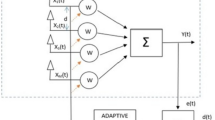Abstract
This study proposes an uncooperative-multi-cell-multiple-input–multiple-output system to increase the throughput of an ill-conditioned wireless MIMO downlink system. The proposed algorithm suppresses the inter-cell interference at each mobile station using a set of adaptive receive beamformers, but handles the intra-cell interference at each base station using a Tomlinson Harashima precoder. Using the singular vectors of channel matrices, the receive beamformers can be designed based on a linear-constrained-minimum-variance criterion. On the other hand, to obtain high enough degree of freedoms for cancelling the intra-cell interference at each base station, the precoder is applied to the re-assembled downlink virtual channel formed by the simplified channel state information. Using the proposed interference suppression techniques, a multi-cell downlink system with multiple uncooperative base stations can be decomposed into a set of parallel subchannels. The resulting system has better performance in channel capacity than conventional MIMO systems. Computer simulations support the validity of the proposed approach.




Similar content being viewed by others
References
Tse, D., & Viswanath, P. (2005). Fundamentals of wireless communication. Cambridge: Cambridge University Press.
Jindal, N. (2008). Antenna combining for the MIMO downlink channel. IEEE Transactions on Wireless Communications, 7(10), 3834–3844.
Chae, C. B., Mazzarese, D., Jindal, N., & Heath, R. W, Jr. (2008). Coordinated beamforming with limited feedback in the MIMO broadcast channel. IEEE Journal on Selected Areas in Communications, 26(8), 1505–1515.
Golden, G. D., Foschini, G. J., Valenzuela, R. A., & Wolniansky, P. W. (1999). Detection algorithm and initial laboratory results using the V-BLAST space-time communication architecture. Electronics Letters, 35, 14–15.
Van Trees, H. L. (2002). Optimum array processing, detection: Part IV of estimation, and modulation theory. Hoboken, NJ: Wiley.
Gershman, A. B., & Sidiropoulos, N. D. (2005). Space-time processing for MIMO communication. Chichester: Wiley.
Tomlinson, M. (1971). New automatic equalizer employing modulo arithmetic. Electronics Letters, 7, 138–139.
Harashima, H., & Miyakawa, H. (1972). Matched-transmission technique for channels with intersymbol interference. IEEE Transactions on Communications, 20(8), 774–780.
Schubert, M., & Boche, H. (2004). Solution of the multiuser downlink beamforming problem with individual SINR constraints. IEEE Transactions on Vehicular Technology, 53(1), 18–28.
Schubert, M., & Boche, H. (2005). Iterative multiuser uplink and downlink beamforming under SINR constraints. IEEE Transactions on Signal Processing, 53(7), 2324–2334.
Ng, B. L., Evans, L. S., Hanly, S., & Aktas, D. (2008). Distributed downlink beamforming with cooperative base stations. IEEE Transactions on Information Theory, 54(12), 5491–5499.
Zhang, H., & Dai, H. (2004). Cochannel interference mitigation and cooperative processing in downlink multicell multiuser MIMO networks. EURASIP Journal on Wireless Communications and Networking (2), 222–235.
Jing, S., Tse, D., Hou, J., Soriaga, J., Smee, J., & Padovani, R. (2007). Downlink macro diversity in cellular networks. In IEEE International Symposium on Information Theory (pp. 1–5).
Thomas, M. (1991). Cover, elements of information theory. Chichester: Wiley.
“IEEE Standard for Local and Metropolitan Area Networks, Part 16: Air Interface for Fixed and Mobile Broadband Wireless Access Systems, Amendment 2: Physical and Medium Access Control Layers for Combined Fixed and Mobile Operation in Licensed Bands and Corrigendum 1,” IEEE Std. 802.16e-2005 and IEEE Std. 802.16-2004/Corrigendum 1-2005, December 7, 2005.
Erceg, V., et al. (2004). IEEE P802.11 wireless LANs TGn channel models. In Zyray wireless.
Haykin, S. (1996). Adaptive filter theory (3rd ed.). Upper Saddle River, NJ: Prentice Hall.
Author information
Authors and Affiliations
Corresponding author
Additional information
This research was supported by Ministry of Science and Technology, ROC, under contract MOST106-2221-E-182-011.
Appendix: Adaptive Implementation of the Receive Beamformer
Appendix: Adaptive Implementation of the Receive Beamformer
Based on (7), the proposed receive beamformer can be implemented using a generalized-sidelobe-canceller (GSC) structure that executes the beamforming process in an adaptive manner. Based on the constraint \(\left( {\mathbf {C}}_{k,m}^{u}\right) ^{H}{\mathbf {w}} =\mathbf {f}_{m}\) in (7), the weight vector \({\mathbf {w}}_{k,m}^{u}\) can be decomposed as the difference of two parts,
where \({\mathbf {w}}_{k,m,\text{q}}^{u}={\mathbf {C}}_{k,m}^{u}\left[ \left( {\mathbf {C}}_{k,m}^{u}\right) ^{H}{\mathbf {C}}_{k,m}^{u}\right] ^{-1} \mathbf {f}_{m}\) is called the quiescent weight vector, which lies in the column space of \({\mathbf {C}}_{k,m}^{u}\), and \({\mathbf {w}}_{k,m,\text{n}}^{u}\) is called the null weight vector, which lies in the null space of \(\left( {\mathbf {C}}_{k,m}^{u}\right) ^{H}\), denoted as \(N\left( \left( {\mathbf {C}}_{k,m}^{u}\right) ^{H}\right)\). After defining the blocking matrix \({\mathbf {B}}_{k,m}^{u}\), which is constructed by the basis vectors of \(N\left( \left( {\mathbf {C}}_{k,m}^{u}\right) ^{H}\right)\), the null weight vector can thus be expressed as
where \({\mathbf {w}}_{k,m,\text{a}}\) denotes the associate coordinate vector. Substituting (31) and (30) into (7) shows, that the constrained optimization problem in (7) can be transformed into an unconstrained optimization problem
where \({\mathbf {R}}_{m}=E\left\{ {\mathbf {y}}_{m}\left[ n\right] {\mathbf {y}} _{m}^{H}\left[ n\right] \right\}\) denotes the autocorrelation matrix of \({\mathbf {y}}_{m}\left[ n\right]\). Some direct manipulations lead to
To avoid estimating the correlation matrix \({\mathbf {R}}_{m}\) in (33), \({\mathbf {w}}_{k,m,\text{a}}\) can also be adaptively obtained by using the least mean square error \(\left( \text{LMS}\right)\) algorithm [17]. Figure 5 shows the GSC structure for the receive beamformer. Letting \(d_{k,m}^{u}\left[ n\right] \overset{\Delta }{=}\left( {\mathbf {w}}_{k,m,\text{q}}^{u}\right) ^{H}{\mathbf {y}}_{m}\left[ n\right]\) and \({\mathbf {u}}_{k,m}^{u}\left[ n\right] =\left( {\mathbf {B}}_{k,m} ^{u}\right) ^{H}{\mathbf {y}}_{m}\left[ n\right]\), the coordinate weight can be adaptively determined by
where \(\mu\) denotes the associated step size and \({\bar{y}}_{k,m}^{u}\left[ n\right] =d_{k,m}^{u}\left[ n\right] -{\mathbf {w}}_{k,m,\text{a}}^{H}\left[ n\right] {\mathbf {u}}_{k,m}^{u}\left[ n\right]\) is the output signal of the receiver beamformer intending for the uth data stream from AP k to MS m. The LMS algorithm converges under the condition [17]
where \(\left\| {\mathbf {u}}_{k,m}^{u}\left[ n\right] \right\|\) denotes the vector 2-norm of \({\mathbf {u}}_{k,m}^{u}\left[ n\right]\).
Rights and permissions
About this article
Cite this article
Wang, YY., Chen, WW. & Yang, SJ. An Interference Cancellation Technique for Distributed MIMO Systems. Wireless Pers Commun 98, 293–309 (2018). https://doi.org/10.1007/s11277-017-4870-3
Published:
Issue Date:
DOI: https://doi.org/10.1007/s11277-017-4870-3





